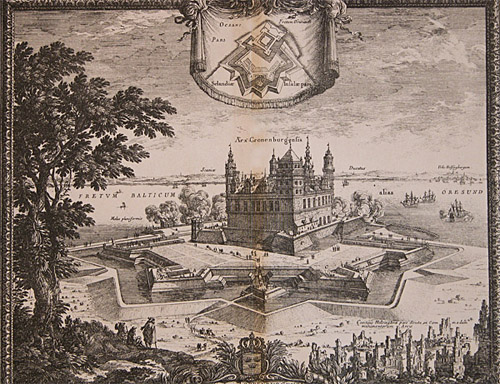| Krigenes følger

| | Karl Gustav krigene og Skånske krig resulterede i store forandringer i både Skåne og Sjælland. I Skåne fandt der, ikke uden store problemer, en ”forsvenskningsproces” sted.
Helsingør blev nu en grænseby og Kronborgs befæstninger blev forstærket. De sjællandske grænsebyer modtog i denne periode et stort antal dansksindede flygtninge fra Skåne.
Den danske rigskansler, Griffenfelsd, anså, fra begyndelsen, at Christian 5.s revanchekrig mod Skåne i 1675 uden en alliance med Frankrigs, som en katastrofe. Og det fik han, med store personlige omkostninger, ret i. |
Forsvenskningen af Skåne

| | Generalguvernøren i Skåne, Johan Gyllenstierna, indtog en stærk og central position. Som en af Kong Karl XI, s mest betroede mænd fik han til opgave at gøre det tidligere danske Skåne til en integreret del af Sverige. Altså, at ”forsvenske” Skåne.
Hertil fandt Gyllenstierna, at der burde etableres en, i forhold til fjenden, Danmark, strategisk rigtigt placeret skånsk ”hovedstad”. Valget faldt på Landskrona, hvor Skånes samlede udenrigshandel, forsvarsværker og statslige administration skulle placeres. Disse planer kom dog i stærk modvind. |
Forsvenskning er et begreb som anvendes i vore historiebøger om den virksomhed, som fulgte efter den svenske magtovertagelse i Skåne. Spørgsmålet er, hvad der egentlig menes med forsvenskning i denne sammenhæng. Handler det om lovmæssig tilpasning, er det fremkomsten af en ny nationalfølelse, eller drejer det sig om en etnisk udrensning for at skabe en nationalitet?
Skånes stilling
Efter at Karl 10. Gustav døde i 1660 blev Sverige styret af en højadelig formynderregering. Denne var klar over vigtigheden af at knytte Skåne nærmere til Sverige, men hvilke relationer skulle der være imellem Stockholm og Skåne? §9 i Roskildefreden fra 1658 dannede på papiret rammen for vidtstrakt skånsk selvbestemmelse.
Problematikken blev taget op på et møde i 1662. Her fastsloges det at gamle love og privilegier fra dansketiden bestemmelser fortsat skulle gælde i Skåne og at skånske adelsmænd, præster, borgere og bønder måtte sende repræsentanter til den svenske rigsdag. Her skulle man så få ”sæde og stemme”. Skåningerne skulle altså som udgangspunkt stå i et ret selvstændigt forhold til Sverige og skulle have, som det hedder, en vis autonomi, samtidig med at man havde indflydelse på Sveriges rigsdag.
Malmø recessen
Overenskomsten fra dette møde, som går under navnet "Malmø Recess", indebar således ingen hård forsvenskning. Grundlæggelsen af Lunds Universitet i 1666 var dog et udslag af vilje til at knytte Skåne tættere til Sverige. Det gælder også placeringen af ”rigtige” svenskere på vigtige poster og oprettelsen af svensk militær sammenslutning i Skåne.
Da den højadelige formynderregering blev erstattet med kong Karl XI og enevældet indført i Sverige blev situationen en anden. Nu krævede kongen ensretning i hele riget! Planerne for forsvenskningen af Skåne blev udformet af generalguvernøren, Johan Gyllenstierna. Han ville fare hårdt frem imod de skåninger, som var danskvenlige. Han krævede troskabsed mod Karl 11., et krav som blev stillet under trusler og som bidrog til afvæbning af snaphanevenlige bønder.

Johan Gyllenstierna |
Landskrona - plan om centralisering
”Sveriges tre største byer er Stockholm, Landskrona og Göteborg”. Sådan ville der måske have stået i nutidens geografibøger, hvis de fantastiske planer der fandtes for Landskrona i slutningen af 1600-tallet, var blevet til virkelighed.
Generalguvernøren i Skåne, Johan Gyldenstierna, ønskede et stærkt udgangspunkt for landskabets forsvenskning. Landskrona ansås for velegnet, fordi man der, fra en central position ved Øresund, skulle kunne overvåge danskerne. Karl XI, som stolede på Gyldenstierna, gik med til at Landskrona skulle spille en fremtrædende rolle. Tanken var at samle Skånes udenrigshandel, befæstninger og byvæsen i denne nye sydsvenske storby.
Gyllenstiernas plan
Gyllenstierna havde tænkt sig en by med plads til 5.000 borgere, hvilket ville have indebåret en samlet befolkning på over 20.000. På dette tidspunkt et meget højt indbyggertal og Landskrona ville med disse planer være endt som Sveriges næststørste by efter Stockholm. Den middelalderlige by skulle ombygges, udvides og forstærkes.
Erik Dahlberg, en alsidig mand med forstand på arkitektur, fæstningsbyggeri og krigsførelse, blev udvalgt til at tegne en ny byplan og han fremlagde flere forslag, men var hele tiden selv i tvivl om de storslåede planer, som han betragtede som urealistiske. Hans endegyldige forslag blev derfor ikke så fantastisk som Gyldenstierne ønskede, men det ville give en by med 1500 borgere, hvilket ikke var så lidt endda.
Idealbyen
Planen blev vedtaget i 1680 og ifølge Dahlberg skulle Landskrona rumme både universitet og bispedømme. Den gamle kirke skulle bibeholdes, ligeledes Citadellet, men derudover var det nye idealer som skulle præge byen. Den skulle være næsten cirkelrund og afspejle den forestilling om en idealby for den svenske stormagt, som Dahlberg havde. En stormagtsby skulle have en stærk befæstning og en næsten fuldkommen symmetri i opbygningen. Dahlberg havde indhentet ideer fra sine rejser og studier ude omkring i Europa. Man kan f.eks. se ligheder med Mannheim i Tyskland.

Dahlbergs skitse over Landskrona | 
Dahlbergs plan over Landskrona |
Protester
Tanken om Landskrona som Skånes absolutte centrum for kirken, undervisning, administration og handel skabte protester i Malmø. Lund og Helsingborg. Derfor mødtes den danske prinsesse Ulrika Eleonora ved sin ankomst til Helsingborg i sammenhæng med det forestående giftermål med Karl d.11., med en velkomsthilsen, som med al ønskelig tydelighed afslørede en meget stor uro omkring den påtænkte centralisering i Landskrona. Med prinsessen fulgte Johan Gyldenstiernea og de fik følgende opfordring at høre i velkomsttalen:
”Thi ihvorvel Helsingborg siges for Landskronas stads bedre opkomsts skyld tilen uundvigelig undergang at være besluttet, kunne vi dog umuligt tænke, at det sted og den by, som himlen med Eders kongelige Højheds første skridt på Sveriges jod har lykkeliggjort, skulle kunne efter denne dag nogen ruin blive underkastet, men i stedet til Eders Kongelige Højheds evige gloriøse ihukommelse med endnu bedre privilegier end den nogensinde har haft, besmykkes, således at stedet derigennem må blomstre til et udødeligt moment, så for alle efterkommere som for alt folk og tungemål udi nærværende tider, og så længe jorden står, bære vidne om det allerhøjstsalige klenodie som udi Eders Kongelige Højheds høje person Sverige bekommet og Danmark givet haver”.
Planerne gennemføres - men i Karlskrona
Johan Gyldenstiernas hurtige død i 1680 medførte at andre byer i Skåne kunne ånde lettet op, eftersom ingen da længere fremførte tanken om Landskrona som storby. Allerede i 1682 besluttede Karl XI at befæstningerne skulle nedrives og Landskrona skulle forvandles til en åben by og dermed ikke blive hovedstad i Skåne. Den svenske stat satsede i stedet på en udbygning af Karlskronas nye orlogshavn. Byplanlægning, arbejdskraft og byggematerialer flyttedes derfor i stedet til Karlskrona. Dermed forblev Landskrona en mindre by, hærget af krig og pest, præcis som andre skånske byer.
Aschebergs metoder
Efter Gyldenstiernas død 1680 blev Rutger von Ascheberg udpeget til generalguvernør og han fortsatte forsvenskningsarbejdet, om end i mildere form. Det lykkedes den svenske administration af få den skånske overklasse til at afstå fra danske(skånske) love og privilegier i 1683. Dermed var Malmø Recess ophævet og Skånes selvstændighed afskaffet. Allerede tidligere havde borgerskabet og præsteskabet antaget svensk lov.

Rutger von Ascheberg | 
Herman Schlyters hus i Helsingborg | 
Skåne 1682 |
Kirkens rolle - ensretning af riget
Kirken spillede en vigtig rolle i et målrettet forsvenskningsarbejde pågræsrodsniveau. I de skånske menigheder udpegedes svenske præster før danske, eller dansksindede. Svenske lærebøger, svensk liturgi og svensksproget gudstjeneste indførtes. Ledende i dette arbejde var biskoppen i Lund, Canutus Hahn.
Man må imidlertid ikke tro, at det blot handlede om at Skåne skulle tilpasses et samlet Sverige. Der fandtes dengang i Sverige en stærk lokal selvbestemmelse, hvilket indebar af forskellige stifter havde forskellige katekismer og salmebøger. Sverige var ikke et homogent land. Man må f.eks. forestille sig, at Gotland og Finland ikke var mere svenske end Skåne. Antallet af stiftssalmebøger var rent faktisk øget ved midten af 1600-tallet og et stort antal forskellige salmebøger fandtes. Også bibeludgivelser var kendetegnet af stor mangfoldighed og mange ukontrollere udgaver var udkommet. Det er på denne baggrund at kravet om ensartede religiøse bøger for hele riget skal ses.
Sverige fik således sin første rigssalmebog i 1695, en revideret variant af den som året før blev fremlagt af hovedprædikanten Jesper Svedberg. På samme måde fik landet i 1703 en rigsbibel, den såkaldte Karl d.12. bibel, som en bibelkommission under Haqvin Spegels ledelse udarbejdede. Endvidere indførtes ny kirkelov 1686, en katekismus 1689 og en alterbog1693. Alt i alt blev der gjort en virkelig kraftanstrengelse for at skabe uniformitet i Sverige på det kirkelige område. Skåne var indbefattet i dette arbejde, men det handlede ikke kun om dette område.

Fra Christian 4. til Carl XI |
Sprogets betydning
Givetvis fandtes der et særligt anliggende i Skåne og det gjaldt sproget. Indførelse af svensk som læse- og skriftsprog gennemførtes med nye ABC-bøger og de ovennævnte religiøse skrifter, men understøttedes også af at læsekyndigheden hos den skånske almue var ganske lav og at svensk derfor for mange blev det første læsesprog.

Skolebøger på svensk |
Glidende overgang
De skånske bønder fik støtte og visse skattelettelse og dermed følte de sig ikke ringere behandlet under svensk styre end under dansk. Desuden var en vis mistro mod danskerne opstået i en del byer på grund af de plyndringer og hærgninger danske soldater havde udført under Skånske krig. Det gælder især den skånske sydkyst, hvor især Skanør, Trelleborg, Ystad og Simrishamn blev ilde medtagne.
En blanding af trusler, løfter, straf og belønning medvirkede til at svensk lov, svenske privilegier, svensk kirkeskik og svensk læsesprog blev indført på relativ kort tid i Skåne. Det bidrog også til at kun få skåninger stillede op på dansk side i krigen 1709-10.
Den forsvenskning som gennemførtes i slutningen af 1600-tallet og i begyndelsen af 1700-tallet handlede om at skabe et mere ensrettet Sverige med samstemmende love, ens gudstjeneste og sprog, men disse bestræbelser gjaldt ikke kun Skåne. Om nogen ny nationalfølelse var der ikke tale. Det var stadigvæk landsby- og byfællesskabet som gav samhørighed. Skåningerne, præcis som andre svenskere, fik først fædrelandsfornemmelse side om side medhjemstavsfølelsen da nationalismen slår igennem i 1800-tallet. Det var heller ikke førend da at nationalistiske monumenter, som f.eks. Magnus Stenbock-statuen i Helsingborg, blev rejst. Måske er, når det gælder ensretningen i 1600-tallet, svensktilpasning et bedre ord en forsvenskning.Helsingør og Kronborg

| | Karl Gustav-krigene gik hårdt udover byen. Og svenskernes bombardement af Kronborg, hvor bl.a. sydtårnet gik til, betød at man lagde planer for en omfattende udbygning af fæstningsanlæggene rundt om slottet.
Forslagene om en genopførelse af sydtårnet er, underligt nok, aldrig blevet realiseret.
Svenskeren Erik Dahlberg gav allerede under krigen et forslagt til dette. |
Helsingør i krigens skygge
For Helsingørs vedkommende kulminerer krigsbegivenhederne ved Karl Gustavkrigene med byens belejring og Kronborgs erobring i 1658. De samlede omkostninger, eller om man vil tab, ved belejringen opgøres af byens borgere til 500.000 rigsdaler. Efter fredslutningen med Sverige i 1660 forøges byens indbyggertal med tilflyttende skåninger, hidlokket med tilbud om skattefrihed i 25 år og i 1675 består byen af 833 familier inddelt efter 10 skatteklasser.
Bysamfundene på Sjællandssiden er tilsyneladende dybt forarmede efter Skånske Krig. I Helsingør øges skattetrykket i de efterfølgende år på grund af fraflytning, og det angives, at der i året 1688 er flere hundrede ledige gårde og huse og at familiernes antal er formindsket fra 800 til 300. Fra slutningen af 1680erne lettes skattebyrden på forskellig vis og i 1690 bliver byen fritaget for at betale grundskat i 10 år med henblik på at bringe den på fode igen og 32 navngivne embedsmænd og borgere fritages for skattebetaling.
Omkring århundredeskiftet er der stadigvæk store problemer med tomme huse og fraflytning og der berettes, at medlemmer af færgelauget tager hyre på fremmede skibe. Selv ejede byen ikke et skib til udenlandsfart, kun 12 mindre fartøjer til indenlands sejlads, men måtte årligt svare omkring 20.000 rigsdaler i skatter og afgifter og som minimum sørge for 720 mands indkvartering.
Kronborgs befæstning
Allerede efter fredsslutningen i 1660 syslede man med planer om at forstærke fæstningsværkerne omkring Kronborg. Det var åbenbart at fæstningen ikke havde stået distancen under den svenske belejring. Det store sydtårn var blevet skudt ned og i det hele taget lå slottet alt for tæt på byen, således at svenskerne fra selve bymuren og de tilstødende kvarterer kunne beskyde Kronborg direkte.
Sydtårnet blev skudt ned og aldrig rekonstrueret i sin opringdelige form. Det sønderskudte kvarter af byen, som lå op til Kronborg blev heller aldrig genopført, hvilket på længere sigt gav mulighed for udbygning af fæstningsanlægget og anlæggelse af en egentlig havn.

Kronborg før bombardementet | 
Kronborg bliver en grænsefæstning | 
Kronborg 1660 | 
Helsingør i fugleperspektiv |
Kroneværket
Fra 1663 stammer en plan af Kronborgs befæstning, der angiver en forstærkning, som tilsyneladende indbefatter den tidligere slotshavn og en bedre afrunding ned imod stranden. Det er dog først efter Skånske Krig i året 1688 man for alvor begynder at iværksætte den udvidede befæstningsplan. Arbejdets ledelse overdrages Dominicus Pell, der blev indkvarteret i Helsingør "tillige med 30 heste og disses oppassere, 26 murersvende, 1 skibsbygmester med svende samt 5 underofficerer 1 tambour og 70 mand af livgarden".
Den ydre befæstning der fuldendes i løbet af 1690erne fik navnet Kroneværket og over Kroneværksporten findes en samtidig indskrift forfattet af Thomas Kingo:
Trin ind, om Du est værd, jeg lader op min Bue
Og åbner Pladsen til det Cronet Slot at skue,
Tre Konger der har ført af Vand, af Ild, af Skud,
Trods Havets Svælg, trods Brand, trods Fjendens Kugle-Brudd!
Nu har Kong CHRISTIAN den Femtes Magt og Møje
Ret Kronet Værket, trods den avindsyges Øje,
GUD give Kongen og hans Slægt en evig Rod,
Så længe Øresund skal kysse Kronborgs Fod.

Kronborg med udvidet befæstning, 1663 | 
Kroneværksporten | 
Udbygningsplan for Kronborg, 1700 | 
Udbygningsplan 1730 |
Fortsat udvidelse
Et kort over byen fra 1697-98 viser, at arbejdet endnu ikke er helt fuldendt på dette tidspunkt. Fæstningsværkerne udvides under Frederik 4.., hvor forværkerne i 1713 omdannes til raveliner i tidens ånd. Kroneværksporten udbygges omkring 1730 og det samlede anlæg er fuldt udbygget omkring 1740. På det tidspunkt har Danmark og Sverige været igennem endnu en indbyrdes krig, som hovedsagelig foregår i Skåne. Kronborg, der nu markerer landegrænsen, fremstår nu som en kaserne med fast garnison og byen Helsingør nu også som garnisonsby. |